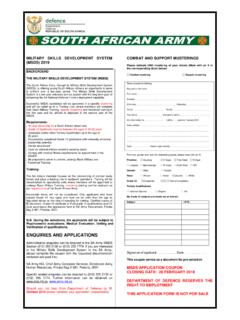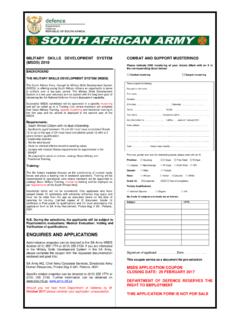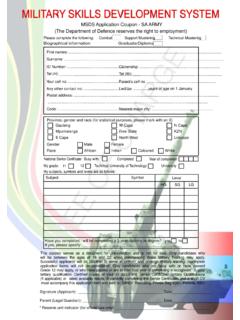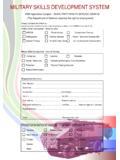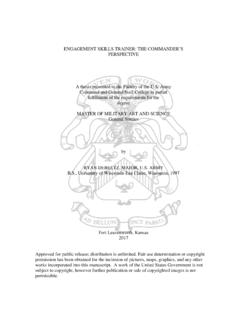Transcription of Like all behavior patterns, interpersonal skills are
1 One of the reasons I got involved in 360-degree feedback technology over ten years ago was the frustration I experienced as a management consultant. A typical assignment had me creating and presenting a customized leadership develop-ment program. I worked hard on these projects, conducted some first-rate training and was well paid for my efforts. The problem was, while the courses were well received, they had little or no impact. In a few weeks, most participants re-turned to their comfortable but ineffective habits. At first I blamed myself.
2 Over time, however, I discovered that the problem wasn t me. It had to do with the very nature of soft skills . Hard skills vs soft skills . In the world of work, hard skills are technical or ad-ministrative procedures related to an organization s core business. Examples include machine opera-tion, computer protocols, safety standards, financial procedures and sales administration. These skills are typically easy to observe, quantify and measure. They re also easy to train, because most of the time the skill sets are brand new to the learner and no unlearning is contrast, soft skills (also called people skills ) are typically hard to observe, quantify and measure.
3 People skills are needed for everyday life as much as they re needed for work. They have to do with how people relate to each other: communicating, listening, engaging in dialogue, giving feedback, cooperating as a team member, solving problems, contributing in meetings and resolving conflict. Leaders at all levels rely heavily on people skills , too: setting an example, teambuilding, facilitating meetings, encouraging inno-vation, solving problems, making decisions, planning, delegating, observing, instructing, coaching, encour-aging and , people come to organizations with interper-sonal behavior patterns already thoroughly ingrained, and they weren t learned in a classroom.
4 Instead, indi-viduals learn how to deal with relationships and other life challenges on the street at a very early age. They observe how the people around them do things, they experiment, and they stick with what works for them. So everyone ends up with a unique portfolio of people skills ; some behaviors may be effective, but others cause problems. By the time employees get to a train-ing room, they ve already worked hard for decades to reinforce the way they deal with people. like all behavior patterns , interpersonal skills are hard-wired in the neuronal pathways of the cere-bral cortex.
5 This means that at some point a behav-ior was repeated often enough that neurons grew dendrites that reached out to other neurons to make the connections needed to make behavior pattern automatic. A myelin sheath coated the cells like elec-tric wire insulation, making the connection extremely efficient. The end result: these ways of behaving now feel natural, easy and comfortable. The bottom line. Introducing a new interpersonal skill is extremely difficult, because it means replacing the old skill. The brain may be an information processor, but it doesn t work like a digital computer.
6 There is no delete key for unwanted programs. behavior patterns are physically established at the brain cell level. Any new pattern, even one that makes sense, even one that is desired and expected, will seem extremely awkward. The only way to replace an old pattern will be to establish a new one that gets better results. If this new pattern proves to be more satisfying than the old pattern, and if there s an adequate period of reinforcement, there s a chance that new connec-tions will establish themselves. If the new pathway is a superhighway, it can become the preferred conduit, and over time even a familiar path associated with lots of memories will eventually fall into disuse, just like old Route this reinforcement, however, the pathways will not establish themselves, and most people will predictably fall back on the old, comfortable patterns they grew up with.
7 Unfortunately, this disappointing scenario happens more often than not. An organiza-tion invests heavily in a people skills training pro-gram, no plan for reinforcement is in place, and the intervention fails to have the hoped-for result. There is virtually no return on the investment. The money is mostly is why a program of lectures, group exercises and handouts even a week-long course personally conducted by a world-famous celebrity author can-not by itself provide enough reinforcement to establish the new pathways needed to change ingrained behav-ior patterns .
8 Without reinforcement, even people who want to change are likely to return to their comfortable patterns , and so dysfunctional behaviors remain the same. If this happens too often, employees may come to feel cynical about people skills programs. Frequent an understanding of the brain teaches us about learning is that the only thing that can create perma-nent behavioral change is frequent reinforcement over the long term. If someone who truly desires to change an interpersonal behavior is supported by a knowledgeable coach s ongoing encouragement, new patterns can be established.
9 The most useful perspec-tive on people skills training is that it s an essential first step a necessary introduction to the right way of doing things. After that, ongoing reinforcement of de-sired behaviors has to be there. When a newly trained individual returns to a workplace, he or she needs knowledgeable coworkers to give ongoing feedback, guidance and proven solution is the top-down approach. If executives start by working on their own people skills , then they can establish the right expectations and coach their managers. An organization can em-ploy executive coaches to ensure frequent feedback, encouragement and reinforcement.
10 Managers can then coach their supervisors, who can coach their team members. To provide the desired motivation and accountability, it s a good idea to assess people skills in advance of the training. By far, the easiest, most practical and effective way to do this is 360-degree feedback, which was designed to provide a reasonably objective assessment of skills that are otherwise hard to observe, quantify and measure. Identifying the weak skill areas has two huge bene-fits. For one thing, training programs can be focused on the areas of highest need, making the best use of limited training funds.
